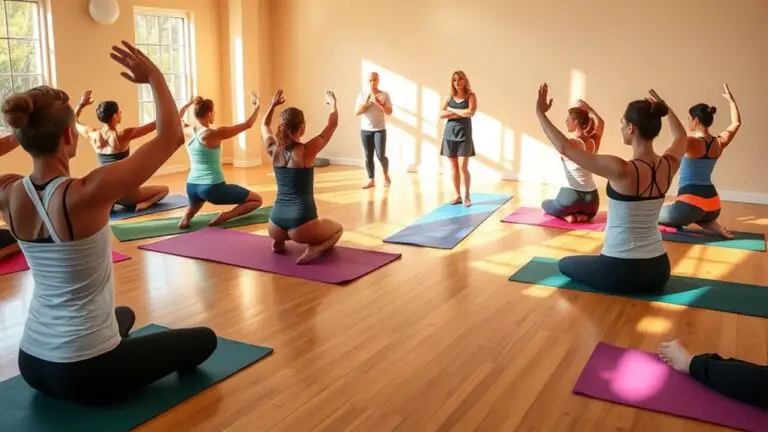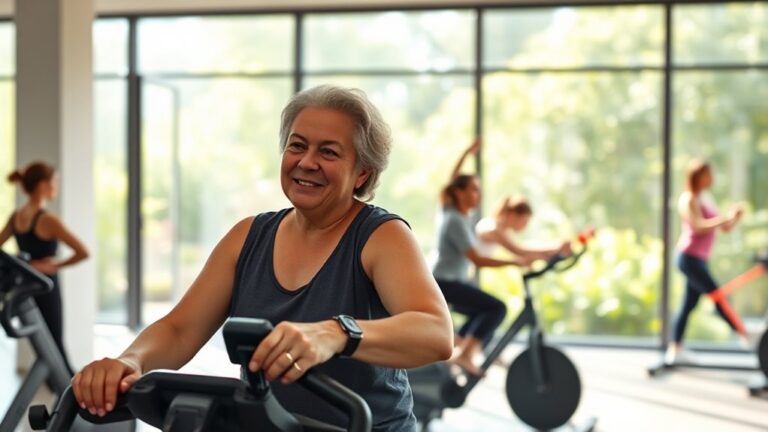The Best Exercises to Strengthen Joints and Ligaments

To strengthen your joints and ligaments, include dynamic warm-ups, strength training, and low-impact cardio in your routine. Focus on exercises like squats and lunges to mimic daily movements, improving joint stability. Incorporate stretching techniques post-workout to enhance flexibility and reduce injury risk. Balance and stability exercises also play an essential role in maintaining joint health. By understanding these components, you can optimize your fitness routine and improve overall mobility and quality of life. There’s more to discover.
Understanding the Importance of Joint and Ligament Health
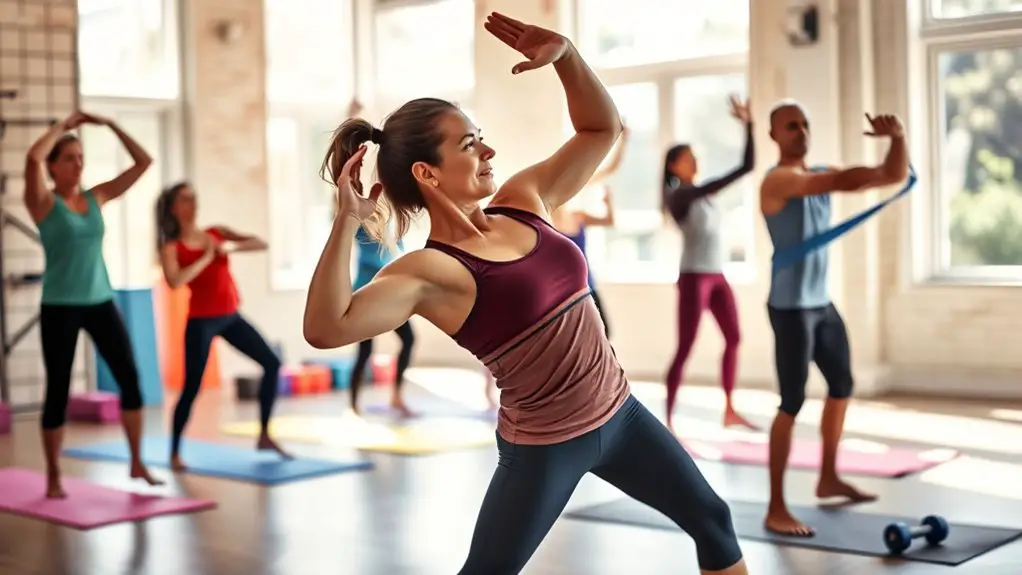
While you may not think about them often, joint and ligament health plays an important role in your overall mobility and functionality. Joints serve as the connection points between bones, allowing for movement and flexibility, while ligaments are strong bands of tissue that connect bones to each other, stabilizing the joints. Maintaining ideal joint mobility is vital for daily activities, from walking to lifting objects. Healthy ligaments guarantee that joints remain stable during movement, preventing injuries such as sprains or tears.
A decline in joint and ligament health can lead to reduced mobility, increased pain, and a higher risk of injury. Factors like age, inactivity, and improper mechanics can adversely affect these tissues. Understanding the importance of joint and ligament functions can motivate you to engage in preventive measures. Prioritizing your joint and ligament health can improve your overall quality of life and enhance your physical performance.
Warm-Up Exercises for Joint Flexibility
Warming up is essential for enhancing joint flexibility and preventing injuries during physical activity. You can incorporate key techniques like dynamic stretching and mobility drills to prepare your body effectively. In this section, we’ll outline recommended warm-up routines to optimize your joint health.
Importance of Warm-Up
Before engaging in any physical activity, incorporating warm-up exercises is essential for enhancing joint flexibility and preventing injuries. Warm-ups prepare your body for the demands of exercise, increasing blood flow to muscles and improving their elasticity. Dynamic stretches are particularly effective, as they mimic the movements you’ll perform during your workout.
- They elevate heart rate, promoting better circulation.
- They enhance range of motion, allowing joints to move more freely.
- They reduce the risk of strains and sprains, aiding in injury prevention.
Key Flexibility Techniques
Warm-up exercises that focus on flexibility play an essential role in preparing your joints for physical activity. Engaging in dynamic stretching is particularly beneficial, as it involves controlled movements that improve your range of motion and enhance blood flow to your muscles. These movements mimic the activity you’re about to perform, reducing the risk of injury. Incorporating flexibility drills, like leg swings and arm circles, can further help in loosening your joints and promoting stability. These exercises not only increase flexibility but also activate the muscles around your joints, providing better support. By integrating dynamic stretching and flexibility drills into your routine, you’re setting a solid foundation for your workout and ensuring your joints are primed for action.
Recommended Warm-Up Routines
To effectively prepare your joints for physical activity, incorporating a structured warm-up routine is essential. This routine should focus on enhancing flexibility and promoting blood flow to your muscles and joints. Incorporating dynamic stretching and mobility drills can greatly improve your range of motion and reduce the risk of injury.
- Dynamic Stretching: Engaging in controlled movements that mimic the activity you’re about to perform warms up the muscles.
- Mobility Drills: Targeting specific joints enhances their flexibility and function, preparing them for stress.
- Gradual Increase in Intensity: Start slowly and progressively increase the intensity to allow your body to adapt.
Implementing these strategies can make a noticeable difference in your overall performance and joint health.
Strength Training for Ligament Resilience
Strength training is essential for enhancing ligament resilience and maintaining joint stability. By incorporating specific exercises, you can strengthen the muscles surrounding your joints, which helps prevent injuries and improves overall function. In this section, we’ll explore recommended strength exercises that target these areas effectively.
Importance of Joint Stability
Joint stability is essential for maintaining overall mobility and preventing injury during physical activities. When joints are stable, they function efficiently, allowing for greater joint mobility and reducing the risk of ligament injuries. Strengthening the muscles surrounding the joints contributes greatly to this stability.
- Enhances proprioception, helping you better understand body positioning
- Reduces wear and tear on ligaments, decreasing injury risk
- Improves performance in physical activities by allowing for controlled movements
Recommended Strength Exercises
Building on the importance of joint stability, incorporating targeted strength exercises can greatly enhance ligament resilience. You should focus on bodyweight exercises and resistance training, as both can effectively strengthen the muscles surrounding your joints. Start with squats and lunges to engage your lower body, promoting strength in the knees and hips. Upper body exercises like push-ups and rows can stabilize shoulder joints. Adding resistance bands can increase the challenge, improving overall joint support. Aim for progressive overload, gradually increasing the intensity of your workouts. Consistency is key; training two to three times a week can yield significant improvements in ligament strength. By prioritizing these exercises, you’ll build a robust foundation for joint health and reduce injury risk.
Low-Impact Cardio for Joint Stability
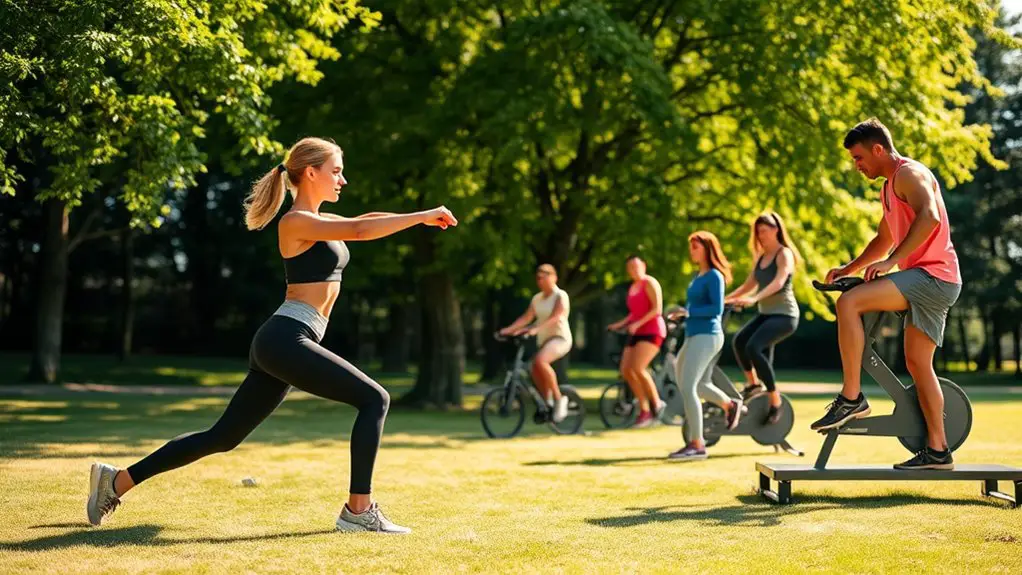
Engaging in low-impact cardio exercises can considerably enhance joint stability while minimizing stress on the body. These activities not only improve cardiovascular health but also support the ligaments and tendons surrounding your joints. Two popular options are aerobic cycling and swimming, both of which provide significant benefits without excessive strain.
- Aerobic cycling can strengthen the muscles around your knees and hips, promoting stability and reducing the risk of injury.
- Swimming benefits include buoyancy, which alleviates pressure on joints while allowing for a full range of motion.
- Walking or elliptical training can enhance circulation and joint lubrication, further supporting overall joint health.
Incorporating these low-impact cardio exercises into your routine will not only enhance joint stability but also improve your overall well-being, making it easier to maintain an active lifestyle. Additionally, engaging in exercises like jumping rope can also strengthen muscles and ligaments around the knee joints, further supporting knee health.
Stretching Techniques to Enhance Flexibility
While many people focus on strength training and cardio, incorporating stretching techniques into your routine is essential for enhancing flexibility and overall joint health. Dynamic stretching, which involves controlled movements that gently take your muscles through their full range of motion, is particularly beneficial before workouts. It prepares your joints for activity, reducing injury risk. Examples include leg swings and arm circles, which help activate muscles and improve circulation.
On the other hand, static stretching involves holding a stretch for a set period, typically 15-60 seconds, and is best performed after exercise when muscles are warm. This technique helps lengthen the muscles and improves flexibility over time, enhancing joint mobility. Incorporating both dynamic and static stretching into your regimen will not only enhance your flexibility but also contribute to stronger, healthier joints and ligaments. Prioritizing these practices can lead to improved overall physical performance.
Balance and Stability Exercises
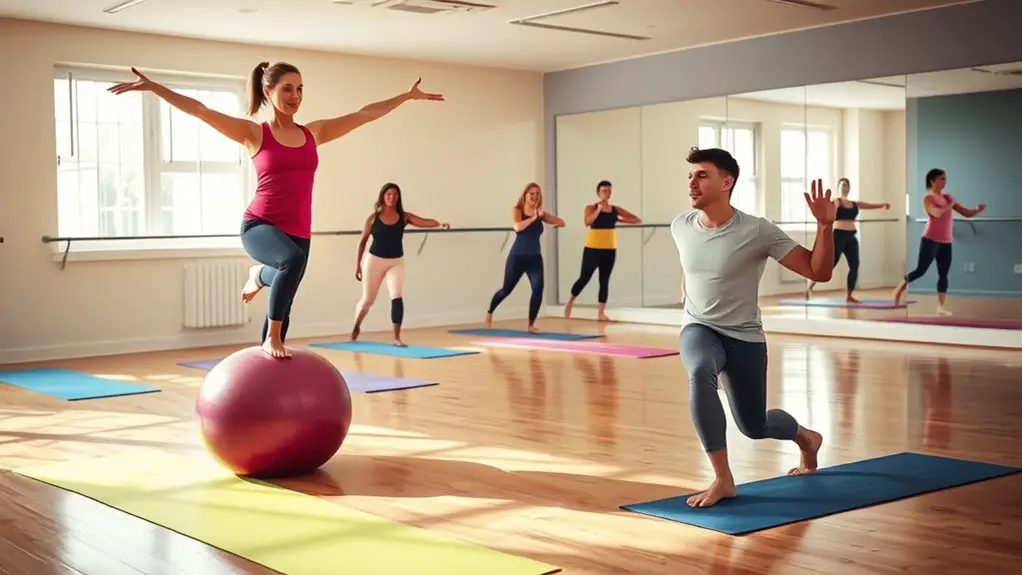
As you incorporate balance and stability exercises into your routine, you’ll find they play an essential role in enhancing joint function and preventing injuries. Balance training helps improve proprioception, which is vital for maintaining joint alignment and reducing the risk of falls. Stability drills, such as single-leg stands or stability ball exercises, engage your core and lower body muscles, contributing to overall joint health.
Consider including the following in your workout regimen:
- Single-leg balance: Enhances proprioception and strengthens ankle joints.
- Balametrics: Incorporates dynamic movements to improve stability and coordination.
- Core stabilization exercises: Strengthen your abdominal muscles, supporting your spine and pelvis.
Additionally, integrating single-leg squats can further enhance your balance and stability, making them a valuable addition to your training.
Functional Movements for Daily Activities
How can functional movements enhance your everyday activities? By incorporating functional fitness exercises, you can improve your daily movement patterns, making routine tasks easier and safer. These movements mimic real-life activities, such as squatting, bending, or lifting, and help develop strength, flexibility, and coordination.
For instance, practicing squats can enhance your ability to sit down and stand up from chairs, while lunges can improve your ability to navigate stairs or uneven surfaces. Additionally, core-strengthening exercises like planks promote stability, supporting your spine during various tasks. Incorporating exercises like the goblet squat can also help strengthen your legs while minimizing strain on your joints.
Integrating these functional movements into your routine not only strengthens joints and ligaments but also reduces the risk of injury during daily activities. As you establish a strong foundation of functional fitness, you’ll find it easier to perform everyday tasks with confidence and efficiency, enhancing your overall quality of life.
Incorporating Recovery and Rest in Your Routine

Incorporating recovery and rest into your routine is essential for maintaining joint and ligament health, especially after engaging in physical activity. Without proper recovery, you risk overuse injuries that can hinder your progress. Implementing effective rest strategies and active recovery methods can enhance your overall performance.
- Gentle Stretching: Incorporate stretching exercises post-workout to enhance flexibility and reduce muscle tension.
- Low-Impact Activities: Engage in activities like walking or swimming during recovery days to keep your joints moving without excessive strain.
- Adequate Sleep: Prioritize restorative sleep to allow your body to repair tissues and recover effectively.
Frequently Asked Questions
How Often Should I Do These Exercises for Optimal Results?
Imagine you’re training like an ancient warrior, honing your body for combat. For ideal results, you should aim to engage in these exercises at least three to four times a week. This exercise frequency allows your muscles and ligaments to adapt and strengthen effectively. Remember, consistency is key, and balancing intensity with proper recovery will maximize your benefits. Listen to your body, and adjust as needed to guarantee you’re always progressing.
Are There Any Specific Exercises for Older Adults?
Yes, there are specific exercises beneficial for older adults. Incorporating balance training can greatly reduce the risk of falls, while flexibility exercises help maintain joint mobility. Activities like tai chi or yoga enhance both balance and flexibility, promoting overall joint health. Aim for regular sessions to see improvements. Always consult with a healthcare professional before starting any new exercise routine to guarantee safety and appropriateness based on individual health conditions.
Can These Exercises Help With Existing Joint Pain?
Imagine a world where joint pain disappears like magic! While it might not be quite that simple, incorporating specific exercises can certainly bolster your joint health and aid in pain management. These exercises improve flexibility and strength, potentially alleviating discomfort. They help to stabilize the joints and promote better circulation, which can lead to a noticeable decrease in existing pain. Remember, consistency is key in reaping these benefits!
What Are the Best Exercises for Injured Ligaments?
When dealing with injured ligaments, incorporating specific exercises can greatly aid in ligament healing and injury prevention. Focus on low-impact activities like swimming or cycling to maintain strength without overstraining. Gradually introduce stretching and strengthening exercises tailored to your injury. Balance and proprioception training, such as single-leg stands, can enhance stability. Always consult a healthcare professional before starting any regimen to guarantee you’re choosing the best approach for your recovery.
Should I Consult a Doctor Before Starting a New Exercise Routine?
Yes, you should consult a doctor before starting a new exercise routine. A professional evaluation helps identify any underlying health issues and guarantees your plan aligns with your specific needs. This consultation can maximize the exercise benefits while minimizing the risk of injury. Your doctor can recommend tailored activities, considering your fitness level and goals, which is essential for maintaining joint and ligament health as you progress in your routine.




